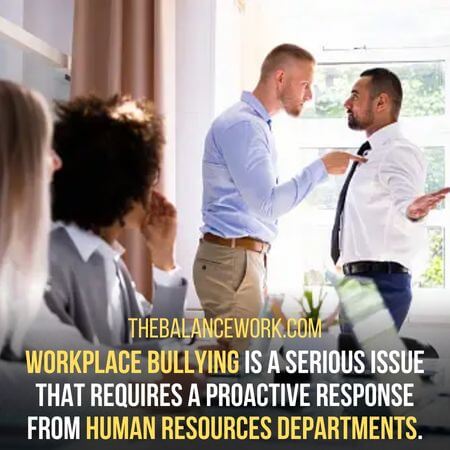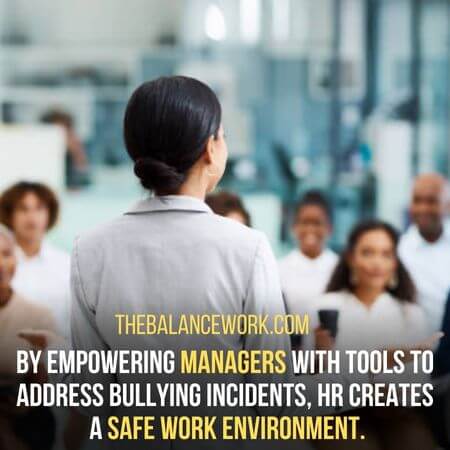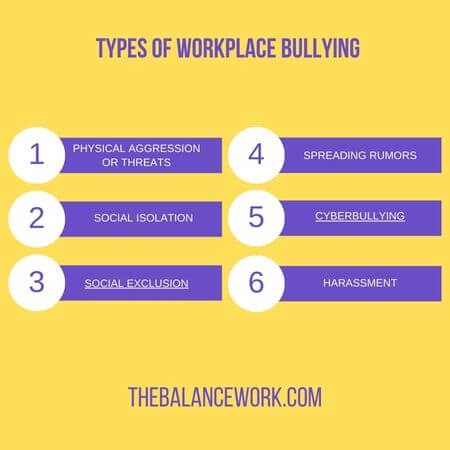Why is HR useless when being bullied? The problem is the perception that HR is ineffective in dealing with bullying, leading to a lack of trust and dissatisfaction.
We’ll discuss the reasons for the ineffectiveness of HR in addressing workplace bullying and proposes strategies to improve their ability to handle such situations.
5 Reasons To Why Is HR Useless When Being Bullied
Human Resources (HR) departments play an important role in organizations.
They manage employee relations, enforce policies, and ensure a safe and inclusive work environment.
However, it is important to acknowledge that HR may sometimes not effectively address bullying issues.
Here are a few reasons why HR may seem useless when dealing with bullying:
1. Lack of Expertise:
HR professionals often receive employment law, policy administration, and conflict resolution training.
But they may not be equipped with specialized training to handle bullying situations.
2. Organizational Bias:
HR departments are part of the organizational structure and may be influenced by organizational politics and biases.
In some cases, HR may prioritize protecting the reputation of the company or key individuals over addressing the concerns of employees who are being bullied.
This can result in inadequate or biased investigations and a failure to act appropriately against the bully.
3. Fear of Retaliation:
Employees who report bullying to HR may fear retaliation from the bully or the HR department.
If the HR department has a history of not addressing bullying effectively, employees may hesitate to come forward or may not trust HR to handle the situation.
4. Insufficient Policies and Procedures:
Some organizations may lack clear policies and procedures for addressing workplace bullying, or their existing policies may be inadequate or poorly enforced.
HR departments can only work within the framework provided by the organization.
If the policies and procedures are not robust, it can hinder their ability to address bullying cases effectively.
5. Confidentiality Concerns:
Employees who report bullying may worry about their complaints becoming public knowledge or being shared with the bully.
Employees who do not trust that their complaints will be handled confidentially may be reluctant to approach HR for assistance.
It is important to note that not all HR departments are ineffective in handling such situations.
Some organizations have robust policies, well-trained HR professionals, and a strong commitment to addressing workplace bullying.
Organizations must prioritize a safe and inclusive work environment and ensure employees have multiple avenues to report and address bullying.
Strategies for Improving HR’s Effectiveness in Addressing Workplace Bullying
Workplace bullying is a serious issue that requires a proactive and effective response from Human Resources (HR) departments.

To enhance HR’s ability to address bullying incidents, the following strategies can be implemented:
1. Increasing Awareness and Education:
HR should develop training programs that educate employees and HR professionals about the different forms of bullying.
They should highlight its impact on individuals and the workplace and the appropriate steps for intervention and resolution.
This training should emphasize the importance of early intervention and prevention.
HR should organize workshops and seminars to educate employees about workplace bullying.
These sessions can cover topics such as recognizing the signs of bullying, promoting respectful communication, and encouraging bystander intervention.
Additionally, HR can distribute educational materials, such as brochures or posters, that highlight the consequences of bullying and the available support resources.
2. Enhancing Investigation and Resolution Processes:
HR should establish well-defined processes for reporting bullying incidents, ensuring employees feel safe and confident in coming forward.
These procedures should outline the steps to be taken, the roles and responsibilities of HR and management, and the timeline for resolution.
Clear communication about the confidentiality of reports should also be provided.
HR should offer guidance and support to individuals who report bullying incidents.
This can include access to counseling services, connecting victims with support networks, and keeping them informed about the progress of the investigation.
HR should also take proactive measures to protect the privacy and well-being of the victims, ensuring they are not subjected to further harm or retaliation.
3. Fostering a Culture of Trust and Accountability:
HR should encourage open dialogue about workplace bullying and create channels for employees to voice their concerns.
This can be done through regular team meetings, anonymous suggestion boxes, or employee feedback surveys.
HR should actively listen to employees’ experiences and promptly address any issues raised.
HR should establish and communicate clear policies that protect individuals who report bullying incidents.
Ensuring that employees feel safe from retaliation when they come forward is crucial.
Additionally, HR should enforce strict consequences for bullying behavior.
These may include disciplinary action, training, or termination, depending on the severity of the misconduct.
By implementing these strategies, HR can improve its effectiveness in addressing workplace bullying.
HR needs to prioritize the well-being of employees.
They must create a supportive and inclusive work environment and take decisive action to prevent and address bullying incidents.
A strong and proactive HR department can contribute significantly to fostering a healthy and respectful workplace culture.
Collaboration Between HR and Management
HR should work closely with management to establish clear expectations regarding their role in preventing and addressing workplace bullying.

This includes setting standards for behavior, promoting diversity and inclusion, and holding managers accountable for fostering a positive work culture.
By emphasizing the importance of respectful and inclusive leadership, HR can ensure that managers prioritize the well-being of their teams:
1. Training Programs:
HR should provide comprehensive training programs for managers that focus on identifying, addressing, and preventing bullying in the workplace.
This training should equip managers with the necessary skills and knowledge to recognize the signs of bullying.
They must teach how to handle complaints effectively and promote respectful communication among their team members.
By empowering managers with the tools to address bullying incidents, HR can enhance their ability to create a safe and supportive work environment.
2. Monitoring & Evaluating:
HR should establish a systematic process for monitoring and evaluating the effectiveness of the implemented anti-bullying measures.
This can involve collecting data on reported incidents, analyzing trends, and assessing the outcomes of investigations and interventions.
Regular assessments will help HR identify areas for improvement and make informed decisions regarding policy changes.
This way, they can measure the impact of their efforts in addressing workplace bullying.
3. Feedback From Employees:
HR should create channels for employees to provide feedback on their experiences with the HR department’s handling of bullying incidents.
This can be through anonymous surveys, focus groups, or confidential feedback.
By actively seeking employee input, HR can gain valuable insights into their processes’ perceived effectiveness and identify improvement areas.
4. External Support and Resources
In cases where internal interventions are insufficient or when conflicts are particularly complex, HR can engage external mediation services.
Mediators can provide an unbiased perspective, facilitate open communication, and help find mutually agreeable solutions.
By bringing in external expertise, HR can ensure a fair and impartial process for resolving bullying incidents, fostering a sense of trust among employees.
HR can benefit from engaging with industry associations and professional networks that promote healthy work environments.
These organizations often provide resources, best practices, and guidance on addressing workplace bullying.
HR professionals can attend conferences, join forums, and participate in networking events to stay updated on the latest developments in creating inclusive workplaces.
Collaborating with industry peers allows HR to gain insights and exchange knowledge, enhancing their ability to address workplace bullying effectively.
Types Of Workplace Bullying
Workplace bullying can take various forms, each with its detrimental impact on individuals and the overall work environment.
These types include verbal abuse, where individuals get insults, derogatory remarks, or offensive language.

Physical bullying involves physical aggression or threats directly harming someone’s well-being.
Relational bullying encompasses social isolation, exclusion, or spreading rumors to damage a person’s reputation.
Cyberbullying occurs through online platforms, including harassment via email, social media, or other digital communication channels.
Each type of workplace bullying can cause significant distress, affecting the mental health, self-esteem, and job satisfaction of those targeted.
Conclusion:
In conclusion, the perceived ineffectiveness of HR in addressing workplace bullying can be a significant concern for employees who are victims of such behavior.
However, organizations can create a safer work environment by implementing strategies to improve HR’s effectiveness in dealing with bullying incidents.
Increasing awareness and education through comprehensive training programs can help HR personnel and employees better identify and address bullying behaviors.
Enhancing investigation and resolution processes by implementing clear procedures and supporting victims can ensure fair and thorough handling of bullying incidents.
Fostering a culture of trust and accountability can create an environment where employees feel safe and supported.
Collaboration between HR and management ensures accountability and promotes a respectful work environment.
Regular monitoring and evaluation allow organizations to assess the effectiveness of anti-bullying measures and make improvements as necessary.
External support, such as mediation services and industry associations, can provide additional resources and expertise.
By implementing these strategies, HR can be more active in addressing workplace bullying, supporting victims, and creating a culture of respect and inclusion.
This, in turn, can enhance employee well-being, job satisfaction, and overall organizational success.
Last Updated on 1 year by Shahzaib Arshad
- 7 Great Signs Your Boss Wants to Help You - October 8, 2023
- How To Explain Dropping Out Of Law School? Detailed Guide - September 6, 2023
- 10 Reasons Employees Get Fired in Workplace - August 27, 2023